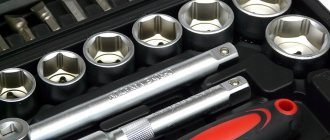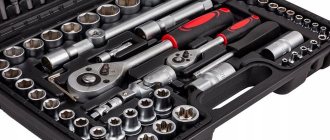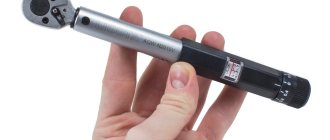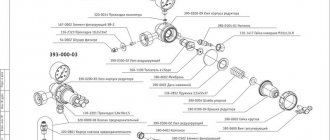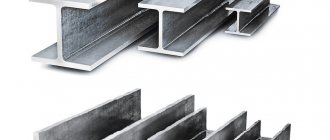The work of assembling and disassembling mechanisms and assemblies involves unscrewing nuts. Some of them are in places where a regular open-end wrench cannot reach. A socket wrench is available for unscrewing such hard-to-reach nuts.
Open-end wrenches
When people talk about a wrench, the first thing that comes to mind is the open-end wrench. The nut is fixed with jaws that resemble horns, hence the name. But according to GOST it is called an open-ended wrench. The longitudinal axis of the handle is located at an angle of 15° to the axis of the head. It is specially designed to work freely in confined spaces. There are keys with an angle between the head and the handle of 70° . In combined versions, the angle is 15° at one end and 70° at the other.
Often open-end ones have two heads, at the ends of the handle, for different sizes of nuts. This significantly reduces the number of tools needed in the kit. Carobs have become widespread because of their versatility, ease of use, and this despite the shortcomings. The main one is that the contact area is small and with strong pressure the corners of the nut are crushed, and if the tool is larger than the required size, then this often happens. If the correct size is used, the impact force will be greater. The thinner the jaws on the key, the higher the likelihood of damaging the corners .
An impact wrench is used to unscrew rusty bolts and nuts; at the other end it has thickenings where blows are applied with a sledgehammer or hammer.
Manufacturers often produce keys with their own lip profile. IBEX instruments have one horn that is shortened, with a short protrusion, and the other has a convex recess of a modified shape. This modification has two obvious advantages:
- Fast operation - easy to remove and rearrange with a simple pull.
- The contact spots are located at a greater distance from the corners of the nut, which reduces the chance of lubricating the edges.
In simpler modifications, corrugation or convexity is applied . This helps to work with bolts and nuts with crumpled edges.
Concept and main characteristics
A wrench is a tool designed to connect and disconnect a threaded fastening joint by rotating threaded parts - nuts, bolts, pipes, etc.
To tighten (unscrew) a part, an external force is applied, created by human muscular force and applied to the object. The torque is equal to the product of the radius vector drawn from the axis of rotation to the point of application of the force and the force vector. An increase in torque is achieved by lengthening the length of the tool handle and increasing the maximum applied force, which directly depends on the physical capabilities of the person.
For the best transmission of torque, it is necessary that the working profile of the wrench fits tightly to the surface of the part, but does not damage it during the application of force and does not damage itself. The hardness of the working profile is achieved by making keys from a special material (tool steel with the addition of vanadium and chromium). The hardness of the working profile of the tool is standardized in national and international standardization systems.
One of the main parameters of a wrench is the size of the jaw - the distance between the jaws of the wrench or the width of the hole. The size is standardized and is measured in millimeters in the metric system. The everyday phrase “10 key” means that the distance between the jaws is 10 mm. In countries with the English system of measures, size is measured in inches. Dimensions and tolerances between jaws are also standardized in international and national standardization systems.
Spanners
A ring wrench, a more advanced type of open-end wrench.
It was made to solve the main drawback - the minimum contact patch. The head rests on the entire area of the nut and the load is evenly distributed over the entire surface. On all six sides, instead of two. And the fact that the contact patch is located far from the corners almost eliminates their crushing in the process. The size of the cap head is smaller than that of the carob head and it is much more convenient for them to work. The spanner wrench profile comes with 12 edges (the most popular option) or 6 (TORX). The advantages of a twelve-sided tool are ease of use; 30° is enough to turn, when TORX requires twice as much. But the second, thanks to the design of the edges, has a larger contact area, which makes it possible to apply more force without fear of blurring the corners.
The ring on the tool can be at the same level as the handle, or at an angle of 15° (with the head bent). A certain position of the ring (sometimes the only correct one) is suitable for different conditions. Flat keys are almost never used. The most common type is with a bent head. The tool has a ratcheting mechanism and is often equipped with a swivel head.
Slip-on, like hinged, are equipped with two rings of different sizes . Percussion modifications are also available, as in horn versions. For cases in which it is impossible to place the tool on top, use a variation with an open ring. This is common when servicing pneumatic and hydraulic installations.
For ease of work in hard-to-reach places, on some models, the handles have a curved shape, and the motor key is shaped like a crescent.
Protection against burglary. Part 3: Check the lock and key for reliability
Let’s immediately make a reservation about the names of the keys: there are so-called “folk” names, common ones, which do not always correspond to the technical characteristics of the lock. For example, (the code elements of a lock with such a key are plates, the name of which is levers) is called “safe” or “butterfly”. Indeed, you can find lever locks , but they are specific and cannot be used on doors in apartments. The name “butterfly” is also not entirely accurate, since the petals can be located on one side.
Also, “a key with vertical cutting” or “a key with perforation” is called a “laser key” - this is also not entirely true, since the cutting of key secrets occurs with a conventional milling cutter with a vertical feed.
But the main thing for us is a common understanding, so we will use different names (even not entirely correct ones) and principles of operation of the lock .
The content of the article
English castle
This type of key is popularly called an English key, and locks of this kind have very low security. this lock in a room where there are no valuables. Opens with a master key. As master keys, you can use paper clips, wires, hairpins, in general, any thin and rigid metal objects.
There are options when a hardened 3-4 cm screw is screwed into the core of such a lock and the core (broken in half) is pulled out with a crowbar, then the bolt is attached with a screwdriver. There are many options. It will take a thief 2 - 3 minutes to open it.
Pin lock
Key for a cylinder, pin lock , so-called high security, produced by the Mosrentgen plant. The secrecy of the castle is actually not great: it is as vulnerable as the English one. The operating principle is identical to locks with standard “English” keys. The only difference is that we also need to lower the lower pins in the cylinder
Opening time - 2 - 3 minutes.
Cross lock
A lock that opens with such a cross-shaped key does not protect your apartment at all.
A criminal can open it in one minute with a Phillips screwdriver. It can be pressed into the keyhole, thereby cutting off all the pins.
"Swedish" castle
“Finnish”, “Swedish”, “ABLOY”. Locks with such a key began to be produced in our country in the late 70s. The security of the castle is low. Over the past two years, it has become one of the most hacked.
A thief only needs 2 - 3 minutes to break into an apartment. Most often, in the Swedish type of lock, the core is knocked out.
This type of lock is more difficult to open with master keys. It will be faster and easier to carefully knock off the outer casing and shake out all the internal plates, then turn the mechanism with a screwdriver. It cannot be said that this method works on all models, but you will be able to open a Chinese or domestic door.
Such locks are well suited for public spaces, but not for apartments. As a rule, it takes the criminal 10 - 15 minutes to open the crime.
Plus: a thief will not be able to open the lock
Level castle
Such locks and the keys to them are called lever locks, popularly called “safe” locks, “butterflies”.
To pick this lock , a thief will need a special tool and from 15 to 40 minutes. The most durable and difficult to crack are those with a “butterfly” key, that is, there are bits on both sides of the rod. The fact is that to open such protection you need at least two master keys to turn them in both directions and work with them simultaneously. It's complicated. And if you also install a special pad there, then the burglar will most likely refuse to open such a lock . This lead lining is placed on the outside of the metal door, and special keys are made for such a lock ; they are slightly longer than usual, just the thickness of the lining. If they make a cast of your key, they will reproduce the bits, but the length of the key will, as a rule, be standard and it will not fit.
Do not leave keys on the inside of the door; impressions can easily be made from them.
Perforated lock
Locks are very common today . People call them perforated or laser-sharpened locks. They are recommended to be installed as an addition to the main lock . In this case, you need to take care of special protection for the cylinder.
Opening time without a protective cover is 2 - 3 minutes, with a cover - 30 - 40 minutes.
Opening time using master keys is 5 - 10 minutes.
High security perforated lock
The lock is quite reliable: it is extremely difficult to open. The weak point of such locks is that they can be knocked out or broken using ordinary locksmith tools. It is recommended to install such locks only in combination with special cylinder protection.
Opening time without a protective pad is 2 - 5 minutes, and 30 - 40 minutes with a protective pad.
From the book by M. Didenko - “Self-defense without weapons. How to win a fight on the street without knowing martial arts"
Combination keys
The instruments combine a carob on one side and a cap on the other. They lack the disadvantages of both, while maintaining the advantages. This option is the most common and in demand. Companies are not limited to combining cap and horn tools. You can often find other options, for example, with an end cap. But if we talk about a combination wrench, without specifying which one, then it is a horn-socket wrench .
With modifications with the head rotated 90°, the palm places emphasis on the large plane of the head, and not on the small one.
Adjustable wrenches
An adjustable wrench is a regular open-end wrench, in which you can change the gap between the jaws. Most often they are used in everyday life, not in professional activities. Masters avoid them because of the following disadvantages:
- The large size of the head makes it difficult to work in hard-to-reach places.
- The play of the horns does not allow the nut to be tightly fixed, which, with little effort, leads to smoothing of the corners and breaking, and this can result in injury.
- It is impossible to generate significant torque due to low strength.
- It is necessary to constantly adjust the jaws while working.
This tool has only one advantage - the ability to stretch the jaws to the desired size. This tool is easily replaced with a socket tool, with replaceable heads.
Main types of classifications
All wrenches can be divided into two main groups: female and male. Tools of the first category with their working profile cover the part from its outer sides. Female wrenches include the most common open-end wrenches, gas wrenches, box wrenches, etc. Male wrenches, on the contrary, are placed in the hole of the part (slot), these include hexagons, star-shaped, Bristol, etc.
Also, all keys are usually divided into the following categories:
- Monolithic
Made from an all-metal structure with a constant working profile size.
- Composite
They consist of a handle and a socket in which interchangeable heads of different sizes are attached.
Socket wrenches
At the end of the tool there is a hexagon-shaped recess for a nut or bolt. Widely used in car repairs. Often, socket wrenches are made in an L-shape, with a notch on both sides, for the same size, and not like socket wrenches. This is due to different purposes : the long part of the tool will easily reach an inconvenient place, while the lever will be shorter and there will be less effort, and when covered with the short end, the torque will be large.
When unscrewing a bolt with a socket wrench, you need to apply more force than when tightening it, due to the souring of the thread. The shorter part of the end is used as a lever when tightening, and the longer part when unscrewing. This helps to cope with situations where it is impossible to unscrew a nut or bolt.
On some models of the socket wrench, a hole is provided in the bend for the protruding parts. The socket tool can be equipped with a twelve-sided notch, with all the associated pros and cons compared to TORX. Models are available with combined hexagonal and twelve-sided ends in one tool. When socket heads are attached through a hinge, they come in different sizes.
Examples of socket wrenches:
- L-shaped socket wrench KING TONY 1080-11 - used for installation of various components, assemblies, devices, products, in various equipment. Used in automatic, service stations and production. The geometry of the tool allows you to easily work in confined spaces. The profile is convenient for use with studs and fasteners located in the recess. The socket wrench is made of chrome vanadium steel with subsequent heat treatment, which ensures high reliability and strength.
- L-shaped socket wrench SKRABAR 27x27. The weight of the tool is 950 grams, the head size is 27 mm. The end tool is made of stainless steel. Well suited for use in a car repair shop, for working in confined spaces.
Models of T-shaped socket wrenches are available, in the form of a cross, with replaceable heads. There are tools with 8 heads , but it has one drawback - its large size. Face tools are widely used in car repairs by both professionals and amateurs.
How to choose the right tool: basic life hacks
The main criteria when choosing a tool are its purpose and size. There is no point in using a gas wrench when unscrewing nuts or using a hex wrench to work on a part with a star spline. When choosing a tool, you should know exactly how and why it will be used.
The dimension is no less important - the wrong size between the jaws can break the thread or damage the edges of the part. A solution might be to use more universal adjustable wrenches. However, practice shows that the simpler the tool, the more reliable and effective it is. It is better to have several sets of simple open-end or ring wrenches than a pair of adjustable wrenches.
The classic material for the manufacture of wrenches is tool steel containing the addition of chromium and vanadium (indicated by the CrV index). They increase the hardness of the working surface of the tool and, most importantly, its working profile. A special surface coating can be used to prevent corrosion.
The best option is galvanizing - it provides excellent protection of the metal coating from corrosion. Chrome-plated tools are too fragile and often chipped as a result of falls or impacts. Oxidation does not provide sufficient protection against corrosion, and the black color characteristic of this coating is impractical - it is difficult to find such a tool in the dark.
What kind of wrenches do you use?
MonolithicComposite
When choosing a tool, you need to take into account the material of its handle. The efficiency of work largely depends on the convenience of how it lies in the hand. For monolithic keys, it is usually made of the same material as the working part. For adjustable or pipe handles, the handle may have a rubber anti-slip pad. Particularly safe tools have a dielectric coating on the handle, which makes them safe when working with parts that may be live.
Tubular keys
The design of a tubular wrench is a pipe with hexagons at the ends, and holes are made in the body for the rod. Hexagon sizes vary. Very often such keys come with the car.
There are L-shaped tubular wrench models. These tools have the same hexagons at the ends.
A spark plug wrench is another type of tubular wrench; the hexagon is located on one side only. Used to replace car spark plugs .
Ratchet wrench
Some models of end and cap type are equipped with a ratchet mechanism (ratchet). An added advantage is the ability to throw the tool. And the small angle required for turning makes screwing and unscrewing the nuts much easier. Ratchet designs vary in the number and size of teeth. To rotate a tool with 72 teeth, 5° is enough, 40 teeth - 9° .
This is very helpful in cramped working conditions. It has one drawback - the ratchet often breaks due to excessive load. Such a tool is much more expensive.
